Organisation Behaviour Report: Sainsbury's Employee Behaviour Analysis
VerifiedAdded on 2023/01/17
|15
|4952
|82
Report
AI Summary
This report provides a comprehensive analysis of organizational behavior within Sainsbury's, a major UK retail chain. The report delves into various aspects, including the impact of different organizational cultures, such as role, power, and person cultures, and their implications for employee behavior and motivation. It examines Handy's Typology Model and French and Raven's Bases of Power to understand how these factors influence the work environment. Furthermore, the report explores motivation theories, including Maslow's need theory and Vroom's expectancy theory, to assess how Sainsbury's addresses employee needs and drives performance. The analysis extends to Chantal's Characteristics of Political Behavior, examining how political factors impact productivity, concentration, and employee morale. Additionally, the report discusses the elements that make effective teams more successful compared to ineffective teams, and it applies organizational behavior concepts to provide a holistic understanding of the organization's dynamics and potential strategies for improvement. The report aims to evaluate internal factors influencing employee behavior and the challenges hindering Sainsbury's growth, providing actionable insights for enhancing organizational effectiveness.
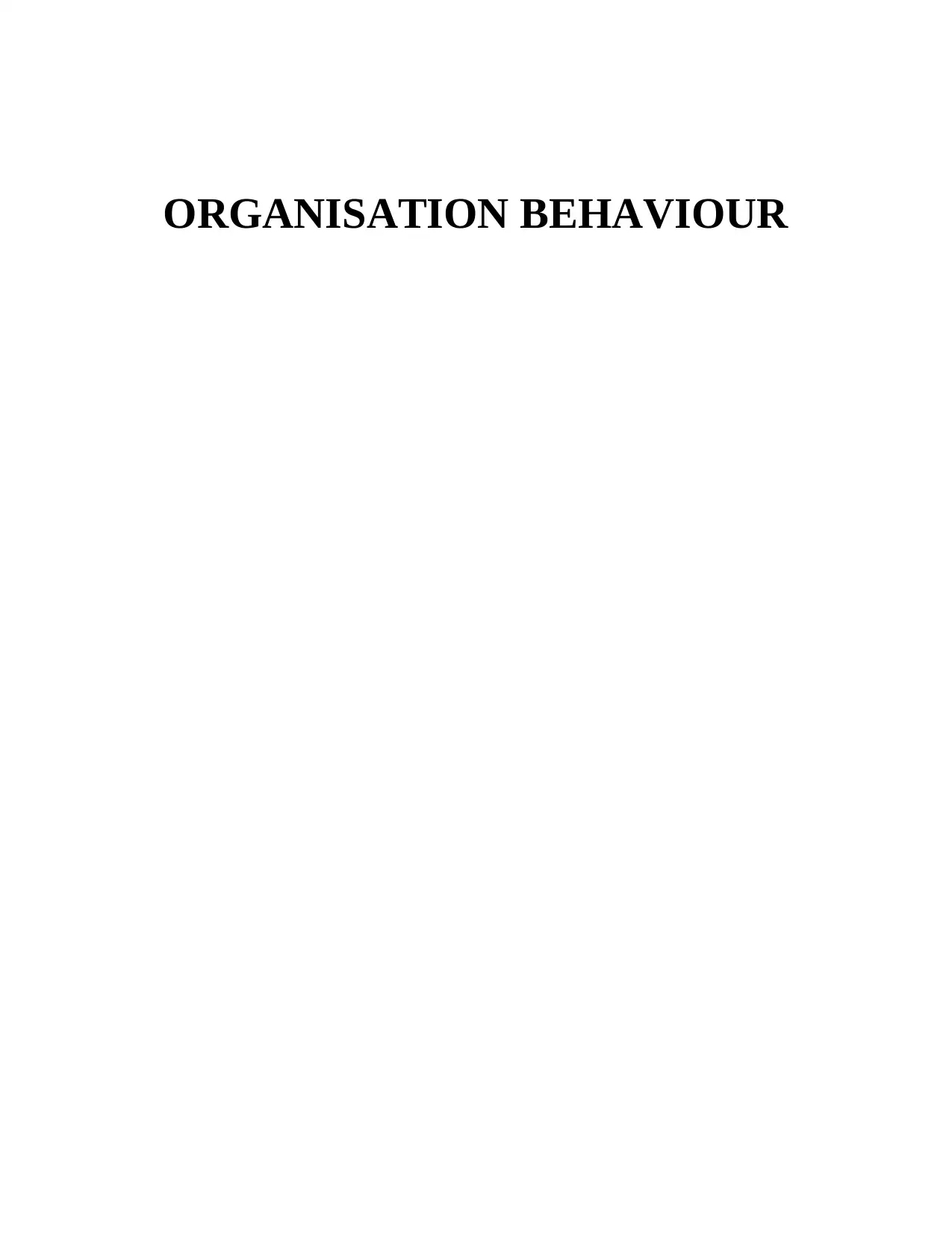
ORGANISATION BEHAVIOUR
Paraphrase This Document
Need a fresh take? Get an instant paraphrase of this document with our AI Paraphraser
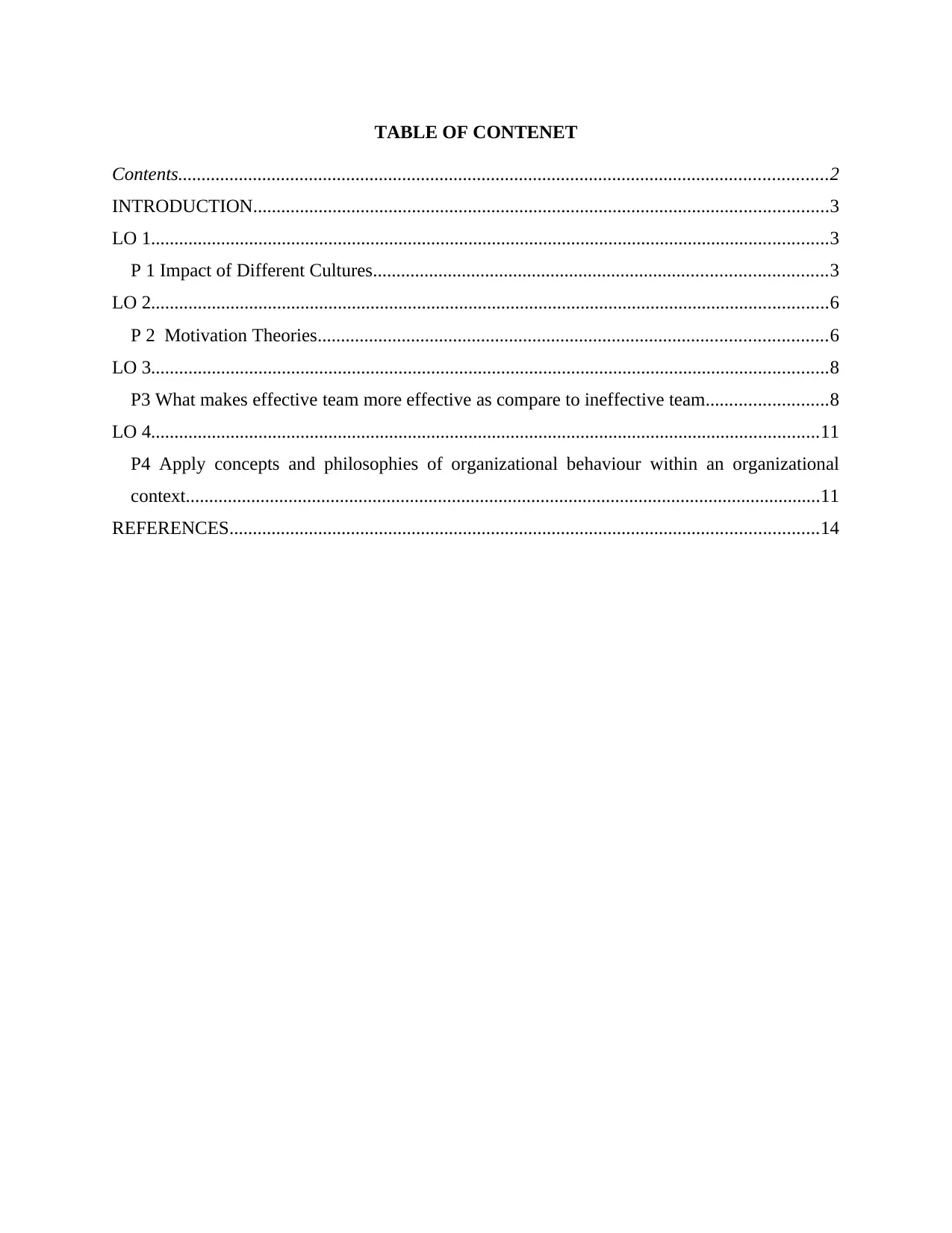
TABLE OF CONTENET
Contents...........................................................................................................................................2
INTRODUCTION...........................................................................................................................3
LO 1.................................................................................................................................................3
P 1 Impact of Different Cultures.................................................................................................3
LO 2.................................................................................................................................................6
P 2 Motivation Theories.............................................................................................................6
LO 3.................................................................................................................................................8
P3 What makes effective team more effective as compare to ineffective team..........................8
LO 4...............................................................................................................................................11
P4 Apply concepts and philosophies of organizational behaviour within an organizational
context........................................................................................................................................11
REFERENCES..............................................................................................................................14
Contents...........................................................................................................................................2
INTRODUCTION...........................................................................................................................3
LO 1.................................................................................................................................................3
P 1 Impact of Different Cultures.................................................................................................3
LO 2.................................................................................................................................................6
P 2 Motivation Theories.............................................................................................................6
LO 3.................................................................................................................................................8
P3 What makes effective team more effective as compare to ineffective team..........................8
LO 4...............................................................................................................................................11
P4 Apply concepts and philosophies of organizational behaviour within an organizational
context........................................................................................................................................11
REFERENCES..............................................................................................................................14
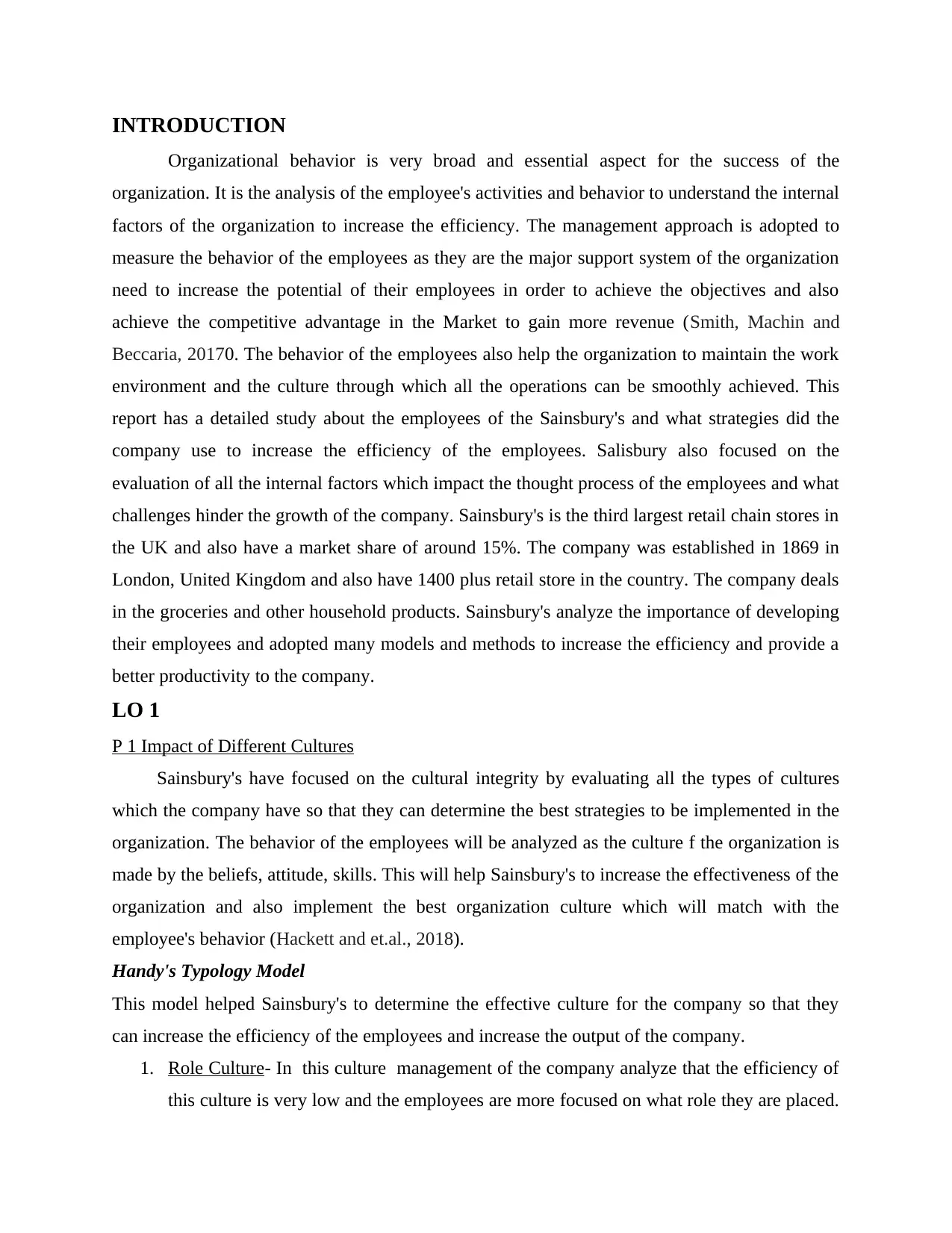
INTRODUCTION
Organizational behavior is very broad and essential aspect for the success of the
organization. It is the analysis of the employee's activities and behavior to understand the internal
factors of the organization to increase the efficiency. The management approach is adopted to
measure the behavior of the employees as they are the major support system of the organization
need to increase the potential of their employees in order to achieve the objectives and also
achieve the competitive advantage in the Market to gain more revenue (Smith, Machin and
Beccaria, 20170. The behavior of the employees also help the organization to maintain the work
environment and the culture through which all the operations can be smoothly achieved. This
report has a detailed study about the employees of the Sainsbury's and what strategies did the
company use to increase the efficiency of the employees. Salisbury also focused on the
evaluation of all the internal factors which impact the thought process of the employees and what
challenges hinder the growth of the company. Sainsbury's is the third largest retail chain stores in
the UK and also have a market share of around 15%. The company was established in 1869 in
London, United Kingdom and also have 1400 plus retail store in the country. The company deals
in the groceries and other household products. Sainsbury's analyze the importance of developing
their employees and adopted many models and methods to increase the efficiency and provide a
better productivity to the company.
LO 1
P 1 Impact of Different Cultures
Sainsbury's have focused on the cultural integrity by evaluating all the types of cultures
which the company have so that they can determine the best strategies to be implemented in the
organization. The behavior of the employees will be analyzed as the culture f the organization is
made by the beliefs, attitude, skills. This will help Sainsbury's to increase the effectiveness of the
organization and also implement the best organization culture which will match with the
employee's behavior (Hackett and et.al., 2018).
Handy's Typology Model
This model helped Sainsbury's to determine the effective culture for the company so that they
can increase the efficiency of the employees and increase the output of the company.
1. Role Culture- In this culture management of the company analyze that the efficiency of
this culture is very low and the employees are more focused on what role they are placed.
Organizational behavior is very broad and essential aspect for the success of the
organization. It is the analysis of the employee's activities and behavior to understand the internal
factors of the organization to increase the efficiency. The management approach is adopted to
measure the behavior of the employees as they are the major support system of the organization
need to increase the potential of their employees in order to achieve the objectives and also
achieve the competitive advantage in the Market to gain more revenue (Smith, Machin and
Beccaria, 20170. The behavior of the employees also help the organization to maintain the work
environment and the culture through which all the operations can be smoothly achieved. This
report has a detailed study about the employees of the Sainsbury's and what strategies did the
company use to increase the efficiency of the employees. Salisbury also focused on the
evaluation of all the internal factors which impact the thought process of the employees and what
challenges hinder the growth of the company. Sainsbury's is the third largest retail chain stores in
the UK and also have a market share of around 15%. The company was established in 1869 in
London, United Kingdom and also have 1400 plus retail store in the country. The company deals
in the groceries and other household products. Sainsbury's analyze the importance of developing
their employees and adopted many models and methods to increase the efficiency and provide a
better productivity to the company.
LO 1
P 1 Impact of Different Cultures
Sainsbury's have focused on the cultural integrity by evaluating all the types of cultures
which the company have so that they can determine the best strategies to be implemented in the
organization. The behavior of the employees will be analyzed as the culture f the organization is
made by the beliefs, attitude, skills. This will help Sainsbury's to increase the effectiveness of the
organization and also implement the best organization culture which will match with the
employee's behavior (Hackett and et.al., 2018).
Handy's Typology Model
This model helped Sainsbury's to determine the effective culture for the company so that they
can increase the efficiency of the employees and increase the output of the company.
1. Role Culture- In this culture management of the company analyze that the efficiency of
this culture is very low and the employees are more focused on what role they are placed.
You're viewing a preview
Unlock full access by subscribing today!
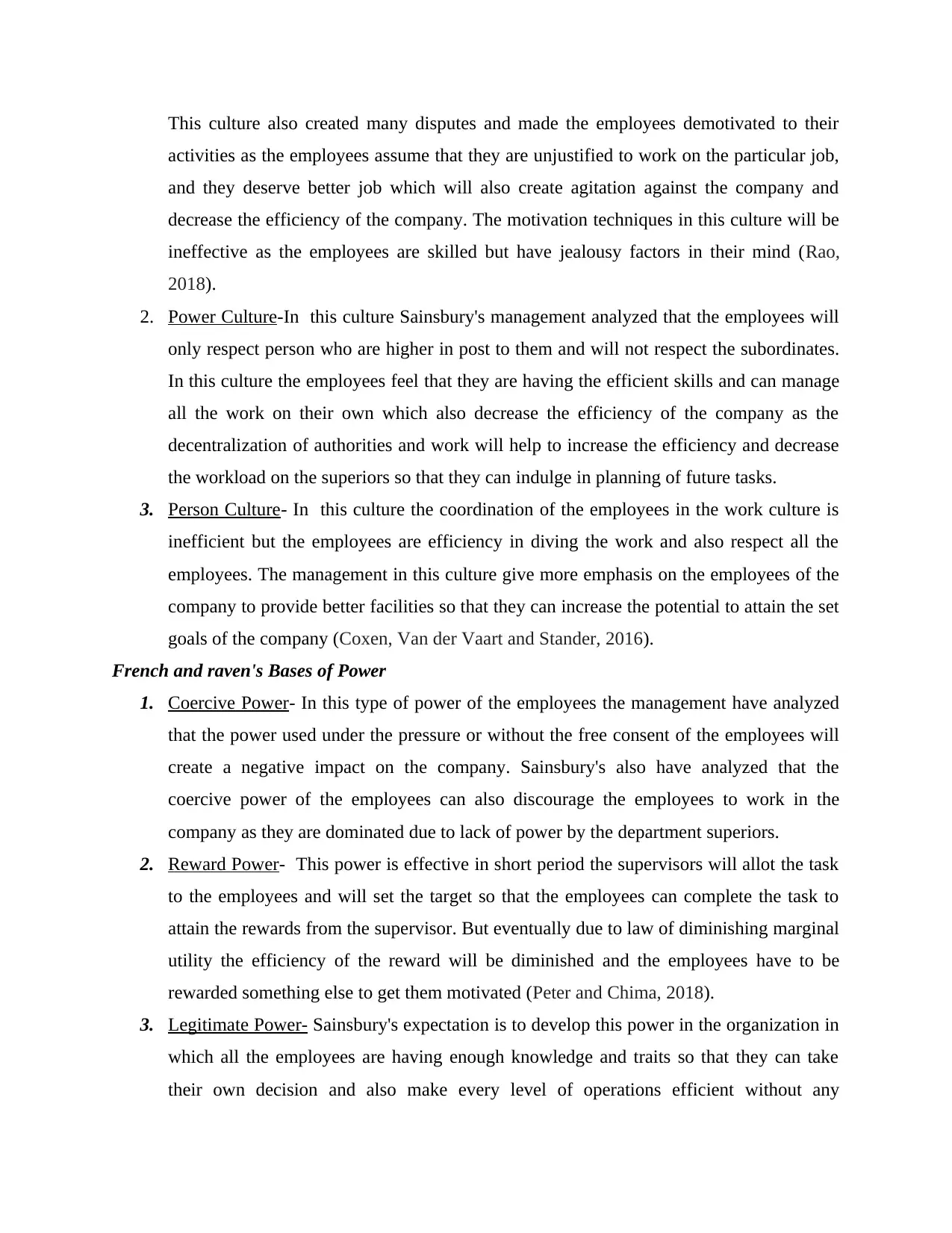
This culture also created many disputes and made the employees demotivated to their
activities as the employees assume that they are unjustified to work on the particular job,
and they deserve better job which will also create agitation against the company and
decrease the efficiency of the company. The motivation techniques in this culture will be
ineffective as the employees are skilled but have jealousy factors in their mind (Rao,
2018).
2. Power Culture-In this culture Sainsbury's management analyzed that the employees will
only respect person who are higher in post to them and will not respect the subordinates.
In this culture the employees feel that they are having the efficient skills and can manage
all the work on their own which also decrease the efficiency of the company as the
decentralization of authorities and work will help to increase the efficiency and decrease
the workload on the superiors so that they can indulge in planning of future tasks.
3. Person Culture- In this culture the coordination of the employees in the work culture is
inefficient but the employees are efficiency in diving the work and also respect all the
employees. The management in this culture give more emphasis on the employees of the
company to provide better facilities so that they can increase the potential to attain the set
goals of the company (Coxen, Van der Vaart and Stander, 2016).
French and raven's Bases of Power
1. Coercive Power- In this type of power of the employees the management have analyzed
that the power used under the pressure or without the free consent of the employees will
create a negative impact on the company. Sainsbury's also have analyzed that the
coercive power of the employees can also discourage the employees to work in the
company as they are dominated due to lack of power by the department superiors.
2. Reward Power- This power is effective in short period the supervisors will allot the task
to the employees and will set the target so that the employees can complete the task to
attain the rewards from the supervisor. But eventually due to law of diminishing marginal
utility the efficiency of the reward will be diminished and the employees have to be
rewarded something else to get them motivated (Peter and Chima, 2018).
3. Legitimate Power- Sainsbury's expectation is to develop this power in the organization in
which all the employees are having enough knowledge and traits so that they can take
their own decision and also make every level of operations efficient without any
activities as the employees assume that they are unjustified to work on the particular job,
and they deserve better job which will also create agitation against the company and
decrease the efficiency of the company. The motivation techniques in this culture will be
ineffective as the employees are skilled but have jealousy factors in their mind (Rao,
2018).
2. Power Culture-In this culture Sainsbury's management analyzed that the employees will
only respect person who are higher in post to them and will not respect the subordinates.
In this culture the employees feel that they are having the efficient skills and can manage
all the work on their own which also decrease the efficiency of the company as the
decentralization of authorities and work will help to increase the efficiency and decrease
the workload on the superiors so that they can indulge in planning of future tasks.
3. Person Culture- In this culture the coordination of the employees in the work culture is
inefficient but the employees are efficiency in diving the work and also respect all the
employees. The management in this culture give more emphasis on the employees of the
company to provide better facilities so that they can increase the potential to attain the set
goals of the company (Coxen, Van der Vaart and Stander, 2016).
French and raven's Bases of Power
1. Coercive Power- In this type of power of the employees the management have analyzed
that the power used under the pressure or without the free consent of the employees will
create a negative impact on the company. Sainsbury's also have analyzed that the
coercive power of the employees can also discourage the employees to work in the
company as they are dominated due to lack of power by the department superiors.
2. Reward Power- This power is effective in short period the supervisors will allot the task
to the employees and will set the target so that the employees can complete the task to
attain the rewards from the supervisor. But eventually due to law of diminishing marginal
utility the efficiency of the reward will be diminished and the employees have to be
rewarded something else to get them motivated (Peter and Chima, 2018).
3. Legitimate Power- Sainsbury's expectation is to develop this power in the organization in
which all the employees are having enough knowledge and traits so that they can take
their own decision and also make every level of operations efficient without any
Paraphrase This Document
Need a fresh take? Get an instant paraphrase of this document with our AI Paraphraser

guidance. This power is not authorized by the company but due to the knowledge and
skills employees treat the individual as the leader and also admire him.
4. Designated Power- this power is assigned to the employee by the management, and they
have the legal authority to manage the operations of the company. This power is only
assigned to those employees who have t effective knowledge to plan and make the
effective use of their knowledge and also help the subordinate. The person is always
humble and respect every employee in the company. They also help to increase the
healthy work environment of the company (Naz and et.al., 2019).
Chantal's Characteristics of Political Behaviour
Sainsbury's have analyzed the factors which can impact the growth of the company and political
factors are one of them. The company have to adopt this model to understand the different
political behaviours of the employees according to the culture of the company to make the
effective strategies and increase the efficiency of the company.
1. Productivity- The politics in the organization can impact the productivity and also
decease the overall efficiency of the company. The legal aspects are also very essential in
assessment of the employee behavior to make the effective strategies and also help the
employees to make the better personality. Politics in the organization can also enable the
employees to distract other employees which will decrease the efficiency (Smith, Machin
and Beccaria, 2017).
2. Concentration- Sainsbury's have also analyzed that political factors will also decrease the
concentration level of the employees as the politics will enable to conspire for the
employees so that they can hinder in the work of other which will create a imbalance in
the culture of the company and the employees will loose their focus.
3. Discourage- the increase of politics among the employees will also increase the
demotivate many employees of the company. Some employees which do not deserve but
have good contacts in management will get promoted and will be considered before
anyone other employees. This will discourage the other employees who try their best to
get promoted and are not even considered due to lack of political traits in them (Hackett
and et.al., 2018).
skills employees treat the individual as the leader and also admire him.
4. Designated Power- this power is assigned to the employee by the management, and they
have the legal authority to manage the operations of the company. This power is only
assigned to those employees who have t effective knowledge to plan and make the
effective use of their knowledge and also help the subordinate. The person is always
humble and respect every employee in the company. They also help to increase the
healthy work environment of the company (Naz and et.al., 2019).
Chantal's Characteristics of Political Behaviour
Sainsbury's have analyzed the factors which can impact the growth of the company and political
factors are one of them. The company have to adopt this model to understand the different
political behaviours of the employees according to the culture of the company to make the
effective strategies and increase the efficiency of the company.
1. Productivity- The politics in the organization can impact the productivity and also
decease the overall efficiency of the company. The legal aspects are also very essential in
assessment of the employee behavior to make the effective strategies and also help the
employees to make the better personality. Politics in the organization can also enable the
employees to distract other employees which will decrease the efficiency (Smith, Machin
and Beccaria, 2017).
2. Concentration- Sainsbury's have also analyzed that political factors will also decrease the
concentration level of the employees as the politics will enable to conspire for the
employees so that they can hinder in the work of other which will create a imbalance in
the culture of the company and the employees will loose their focus.
3. Discourage- the increase of politics among the employees will also increase the
demotivate many employees of the company. Some employees which do not deserve but
have good contacts in management will get promoted and will be considered before
anyone other employees. This will discourage the other employees who try their best to
get promoted and are not even considered due to lack of political traits in them (Hackett
and et.al., 2018).
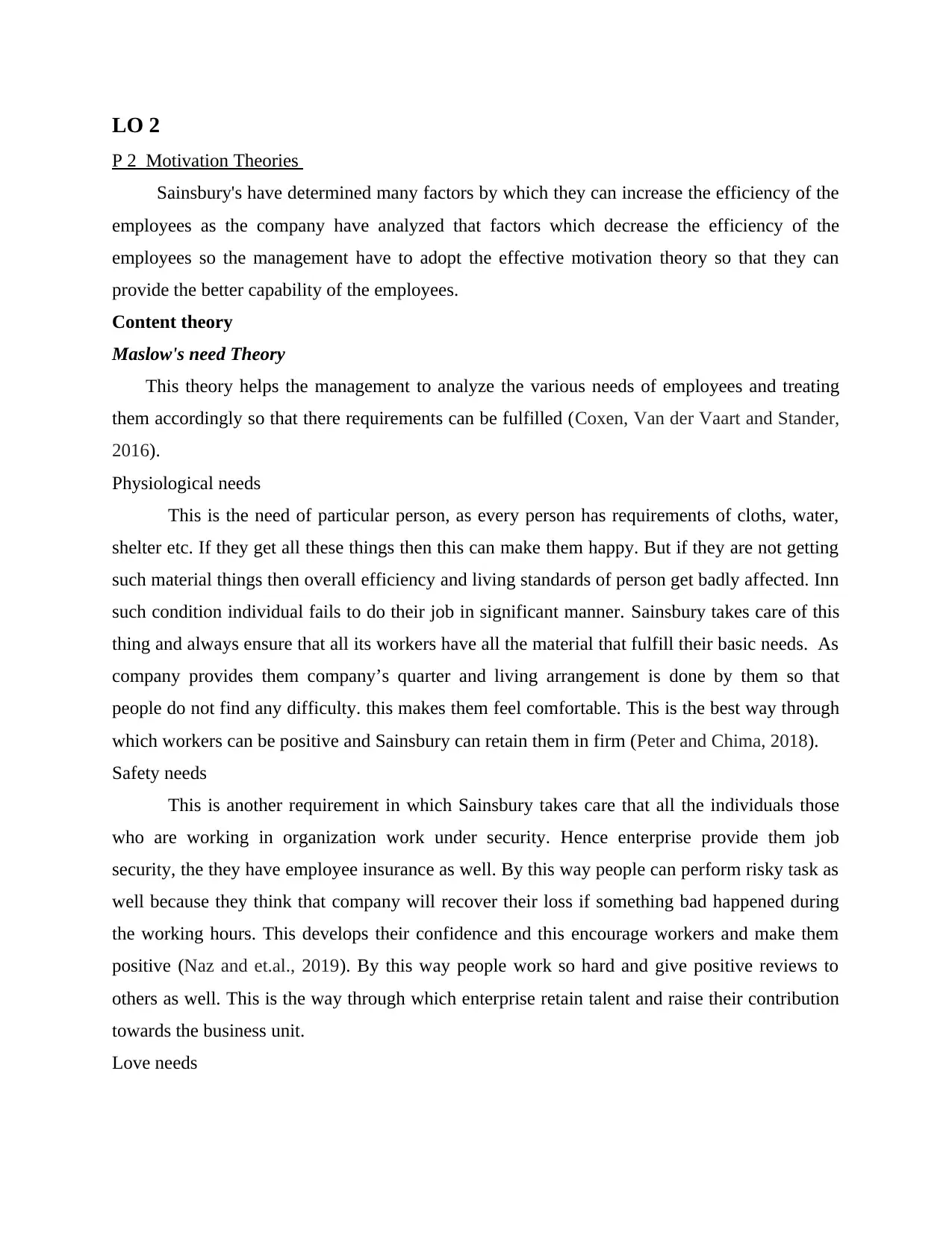
LO 2
P 2 Motivation Theories
Sainsbury's have determined many factors by which they can increase the efficiency of the
employees as the company have analyzed that factors which decrease the efficiency of the
employees so the management have to adopt the effective motivation theory so that they can
provide the better capability of the employees.
Content theory
Maslow's need Theory
This theory helps the management to analyze the various needs of employees and treating
them accordingly so that there requirements can be fulfilled (Coxen, Van der Vaart and Stander,
2016).
Physiological needs
This is the need of particular person, as every person has requirements of cloths, water,
shelter etc. If they get all these things then this can make them happy. But if they are not getting
such material things then overall efficiency and living standards of person get badly affected. Inn
such condition individual fails to do their job in significant manner. Sainsbury takes care of this
thing and always ensure that all its workers have all the material that fulfill their basic needs. As
company provides them company’s quarter and living arrangement is done by them so that
people do not find any difficulty. this makes them feel comfortable. This is the best way through
which workers can be positive and Sainsbury can retain them in firm (Peter and Chima, 2018).
Safety needs
This is another requirement in which Sainsbury takes care that all the individuals those
who are working in organization work under security. Hence enterprise provide them job
security, the they have employee insurance as well. By this way people can perform risky task as
well because they think that company will recover their loss if something bad happened during
the working hours. This develops their confidence and this encourage workers and make them
positive (Naz and et.al., 2019). By this way people work so hard and give positive reviews to
others as well. This is the way through which enterprise retain talent and raise their contribution
towards the business unit.
Love needs
P 2 Motivation Theories
Sainsbury's have determined many factors by which they can increase the efficiency of the
employees as the company have analyzed that factors which decrease the efficiency of the
employees so the management have to adopt the effective motivation theory so that they can
provide the better capability of the employees.
Content theory
Maslow's need Theory
This theory helps the management to analyze the various needs of employees and treating
them accordingly so that there requirements can be fulfilled (Coxen, Van der Vaart and Stander,
2016).
Physiological needs
This is the need of particular person, as every person has requirements of cloths, water,
shelter etc. If they get all these things then this can make them happy. But if they are not getting
such material things then overall efficiency and living standards of person get badly affected. Inn
such condition individual fails to do their job in significant manner. Sainsbury takes care of this
thing and always ensure that all its workers have all the material that fulfill their basic needs. As
company provides them company’s quarter and living arrangement is done by them so that
people do not find any difficulty. this makes them feel comfortable. This is the best way through
which workers can be positive and Sainsbury can retain them in firm (Peter and Chima, 2018).
Safety needs
This is another requirement in which Sainsbury takes care that all the individuals those
who are working in organization work under security. Hence enterprise provide them job
security, the they have employee insurance as well. By this way people can perform risky task as
well because they think that company will recover their loss if something bad happened during
the working hours. This develops their confidence and this encourage workers and make them
positive (Naz and et.al., 2019). By this way people work so hard and give positive reviews to
others as well. This is the way through which enterprise retain talent and raise their contribution
towards the business unit.
Love needs
You're viewing a preview
Unlock full access by subscribing today!
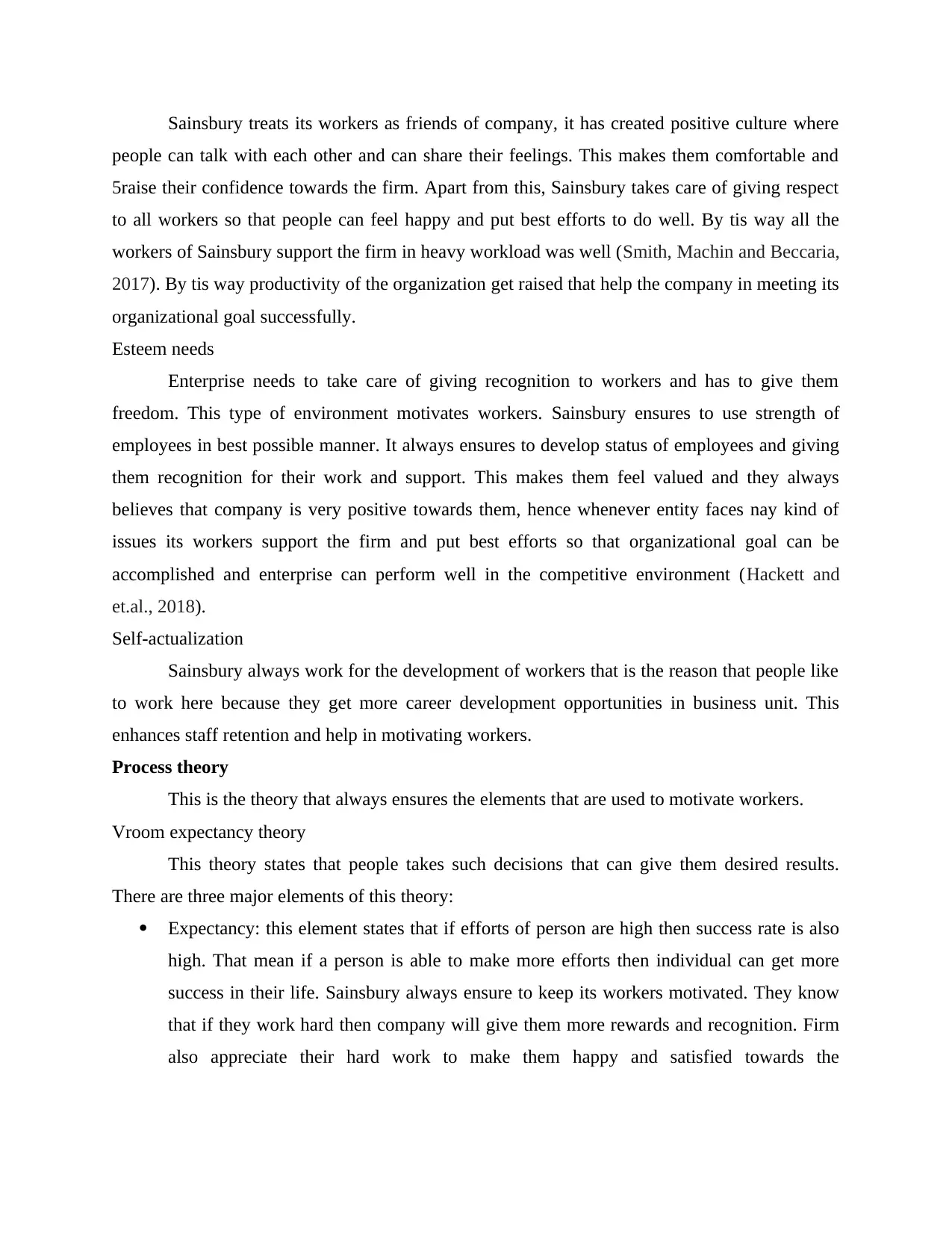
Sainsbury treats its workers as friends of company, it has created positive culture where
people can talk with each other and can share their feelings. This makes them comfortable and
5raise their confidence towards the firm. Apart from this, Sainsbury takes care of giving respect
to all workers so that people can feel happy and put best efforts to do well. By tis way all the
workers of Sainsbury support the firm in heavy workload was well (Smith, Machin and Beccaria,
2017). By tis way productivity of the organization get raised that help the company in meeting its
organizational goal successfully.
Esteem needs
Enterprise needs to take care of giving recognition to workers and has to give them
freedom. This type of environment motivates workers. Sainsbury ensures to use strength of
employees in best possible manner. It always ensures to develop status of employees and giving
them recognition for their work and support. This makes them feel valued and they always
believes that company is very positive towards them, hence whenever entity faces nay kind of
issues its workers support the firm and put best efforts so that organizational goal can be
accomplished and enterprise can perform well in the competitive environment (Hackett and
et.al., 2018).
Self-actualization
Sainsbury always work for the development of workers that is the reason that people like
to work here because they get more career development opportunities in business unit. This
enhances staff retention and help in motivating workers.
Process theory
This is the theory that always ensures the elements that are used to motivate workers.
Vroom expectancy theory
This theory states that people takes such decisions that can give them desired results.
There are three major elements of this theory:
Expectancy: this element states that if efforts of person are high then success rate is also
high. That mean if a person is able to make more efforts then individual can get more
success in their life. Sainsbury always ensure to keep its workers motivated. They know
that if they work hard then company will give them more rewards and recognition. Firm
also appreciate their hard work to make them happy and satisfied towards the
people can talk with each other and can share their feelings. This makes them comfortable and
5raise their confidence towards the firm. Apart from this, Sainsbury takes care of giving respect
to all workers so that people can feel happy and put best efforts to do well. By tis way all the
workers of Sainsbury support the firm in heavy workload was well (Smith, Machin and Beccaria,
2017). By tis way productivity of the organization get raised that help the company in meeting its
organizational goal successfully.
Esteem needs
Enterprise needs to take care of giving recognition to workers and has to give them
freedom. This type of environment motivates workers. Sainsbury ensures to use strength of
employees in best possible manner. It always ensures to develop status of employees and giving
them recognition for their work and support. This makes them feel valued and they always
believes that company is very positive towards them, hence whenever entity faces nay kind of
issues its workers support the firm and put best efforts so that organizational goal can be
accomplished and enterprise can perform well in the competitive environment (Hackett and
et.al., 2018).
Self-actualization
Sainsbury always work for the development of workers that is the reason that people like
to work here because they get more career development opportunities in business unit. This
enhances staff retention and help in motivating workers.
Process theory
This is the theory that always ensures the elements that are used to motivate workers.
Vroom expectancy theory
This theory states that people takes such decisions that can give them desired results.
There are three major elements of this theory:
Expectancy: this element states that if efforts of person are high then success rate is also
high. That mean if a person is able to make more efforts then individual can get more
success in their life. Sainsbury always ensure to keep its workers motivated. They know
that if they work hard then company will give them more rewards and recognition. Firm
also appreciate their hard work to make them happy and satisfied towards the
Paraphrase This Document
Need a fresh take? Get an instant paraphrase of this document with our AI Paraphraser
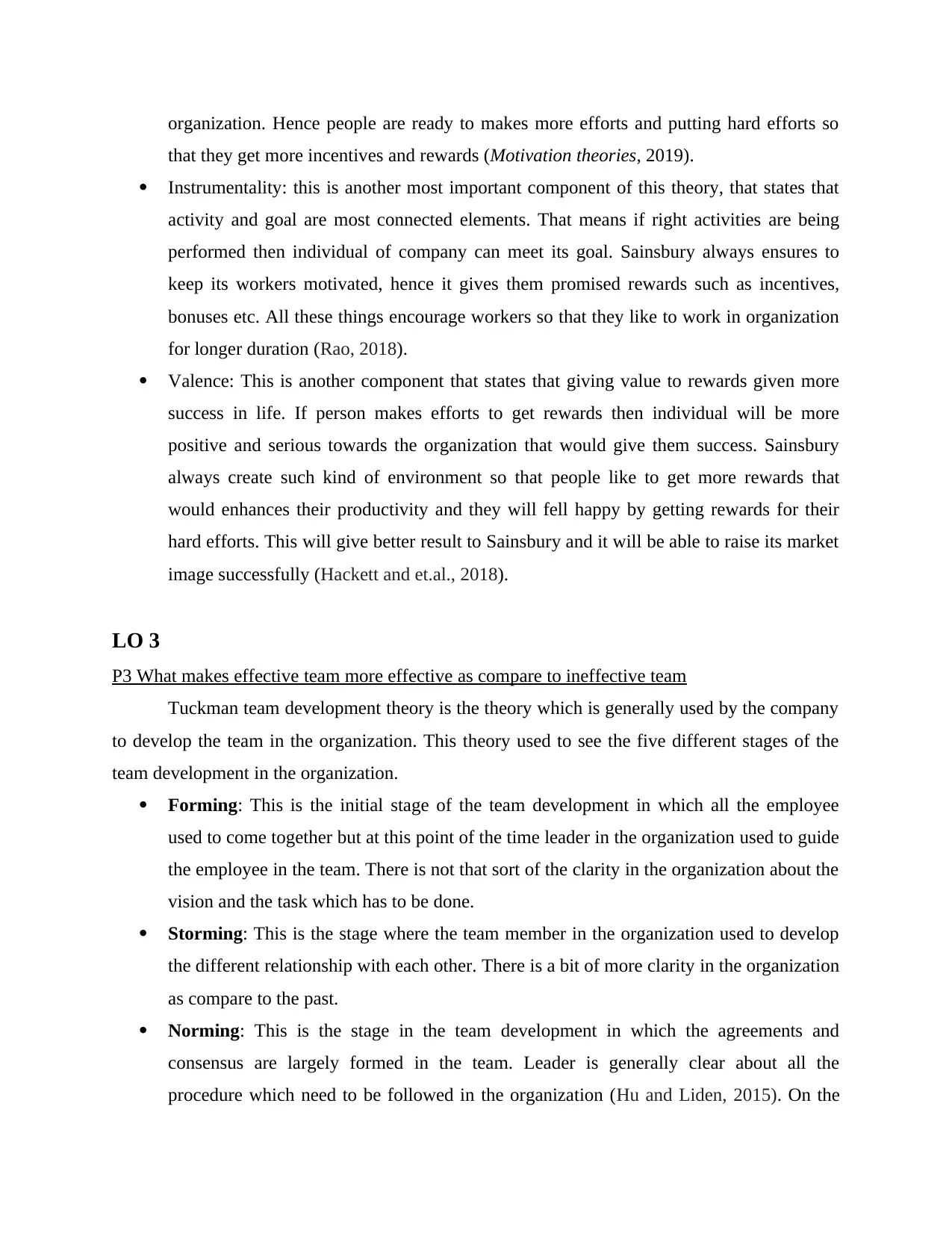
organization. Hence people are ready to makes more efforts and putting hard efforts so
that they get more incentives and rewards (Motivation theories, 2019).
Instrumentality: this is another most important component of this theory, that states that
activity and goal are most connected elements. That means if right activities are being
performed then individual of company can meet its goal. Sainsbury always ensures to
keep its workers motivated, hence it gives them promised rewards such as incentives,
bonuses etc. All these things encourage workers so that they like to work in organization
for longer duration (Rao, 2018).
Valence: This is another component that states that giving value to rewards given more
success in life. If person makes efforts to get rewards then individual will be more
positive and serious towards the organization that would give them success. Sainsbury
always create such kind of environment so that people like to get more rewards that
would enhances their productivity and they will fell happy by getting rewards for their
hard efforts. This will give better result to Sainsbury and it will be able to raise its market
image successfully (Hackett and et.al., 2018).
LO 3
P3 What makes effective team more effective as compare to ineffective team
Tuckman team development theory is the theory which is generally used by the company
to develop the team in the organization. This theory used to see the five different stages of the
team development in the organization.
Forming: This is the initial stage of the team development in which all the employee
used to come together but at this point of the time leader in the organization used to guide
the employee in the team. There is not that sort of the clarity in the organization about the
vision and the task which has to be done.
Storming: This is the stage where the team member in the organization used to develop
the different relationship with each other. There is a bit of more clarity in the organization
as compare to the past.
Norming: This is the stage in the team development in which the agreements and
consensus are largely formed in the team. Leader is generally clear about all the
procedure which need to be followed in the organization (Hu and Liden, 2015). On the
that they get more incentives and rewards (Motivation theories, 2019).
Instrumentality: this is another most important component of this theory, that states that
activity and goal are most connected elements. That means if right activities are being
performed then individual of company can meet its goal. Sainsbury always ensures to
keep its workers motivated, hence it gives them promised rewards such as incentives,
bonuses etc. All these things encourage workers so that they like to work in organization
for longer duration (Rao, 2018).
Valence: This is another component that states that giving value to rewards given more
success in life. If person makes efforts to get rewards then individual will be more
positive and serious towards the organization that would give them success. Sainsbury
always create such kind of environment so that people like to get more rewards that
would enhances their productivity and they will fell happy by getting rewards for their
hard efforts. This will give better result to Sainsbury and it will be able to raise its market
image successfully (Hackett and et.al., 2018).
LO 3
P3 What makes effective team more effective as compare to ineffective team
Tuckman team development theory is the theory which is generally used by the company
to develop the team in the organization. This theory used to see the five different stages of the
team development in the organization.
Forming: This is the initial stage of the team development in which all the employee
used to come together but at this point of the time leader in the organization used to guide
the employee in the team. There is not that sort of the clarity in the organization about the
vision and the task which has to be done.
Storming: This is the stage where the team member in the organization used to develop
the different relationship with each other. There is a bit of more clarity in the organization
as compare to the past.
Norming: This is the stage in the team development in which the agreements and
consensus are largely formed in the team. Leader is generally clear about all the
procedure which need to be followed in the organization (Hu and Liden, 2015). On the
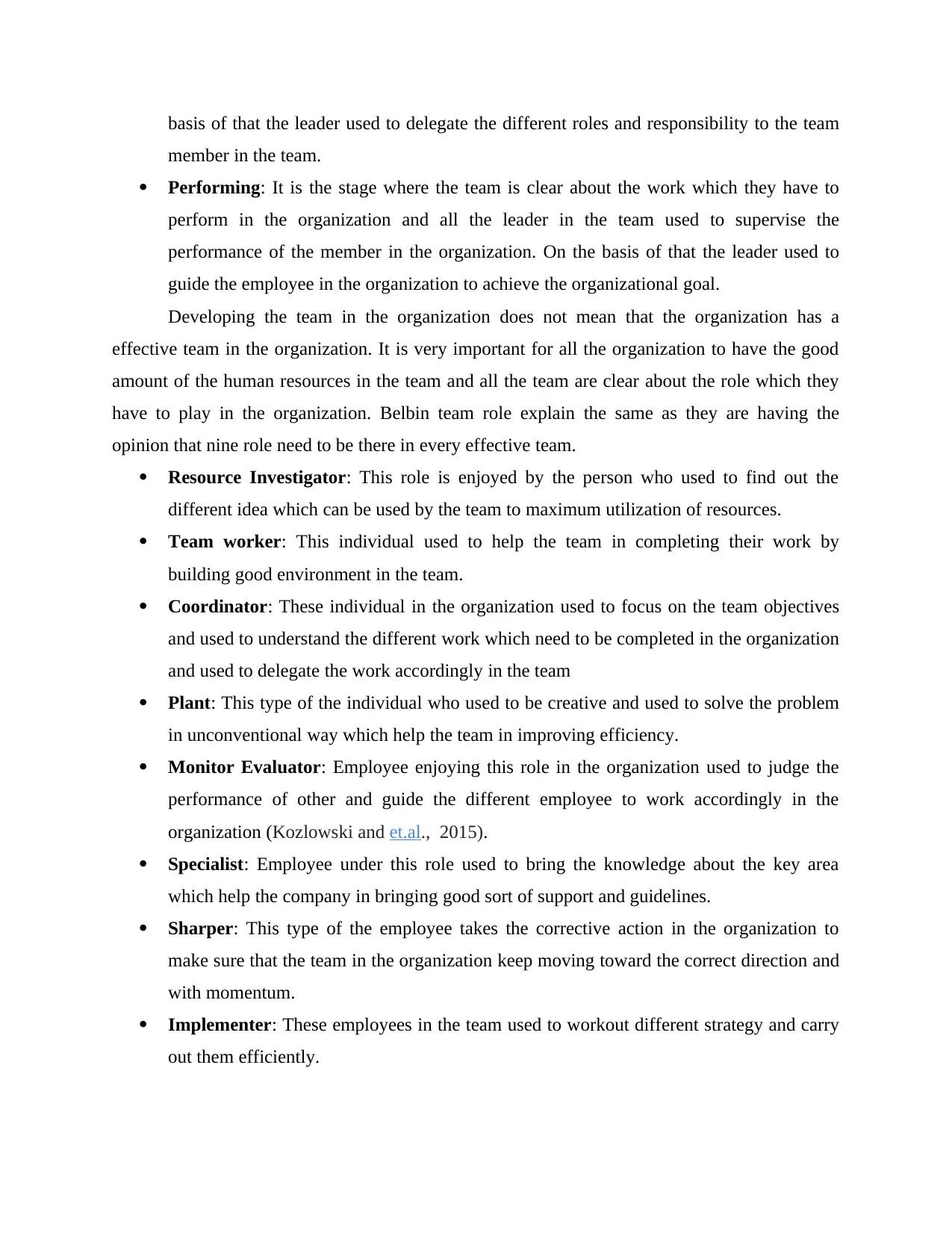
basis of that the leader used to delegate the different roles and responsibility to the team
member in the team.
Performing: It is the stage where the team is clear about the work which they have to
perform in the organization and all the leader in the team used to supervise the
performance of the member in the organization. On the basis of that the leader used to
guide the employee in the organization to achieve the organizational goal.
Developing the team in the organization does not mean that the organization has a
effective team in the organization. It is very important for all the organization to have the good
amount of the human resources in the team and all the team are clear about the role which they
have to play in the organization. Belbin team role explain the same as they are having the
opinion that nine role need to be there in every effective team.
Resource Investigator: This role is enjoyed by the person who used to find out the
different idea which can be used by the team to maximum utilization of resources.
Team worker: This individual used to help the team in completing their work by
building good environment in the team.
Coordinator: These individual in the organization used to focus on the team objectives
and used to understand the different work which need to be completed in the organization
and used to delegate the work accordingly in the team
Plant: This type of the individual who used to be creative and used to solve the problem
in unconventional way which help the team in improving efficiency.
Monitor Evaluator: Employee enjoying this role in the organization used to judge the
performance of other and guide the different employee to work accordingly in the
organization (Kozlowski and et.al., 2015).
Specialist: Employee under this role used to bring the knowledge about the key area
which help the company in bringing good sort of support and guidelines.
Sharper: This type of the employee takes the corrective action in the organization to
make sure that the team in the organization keep moving toward the correct direction and
with momentum.
Implementer: These employees in the team used to workout different strategy and carry
out them efficiently.
member in the team.
Performing: It is the stage where the team is clear about the work which they have to
perform in the organization and all the leader in the team used to supervise the
performance of the member in the organization. On the basis of that the leader used to
guide the employee in the organization to achieve the organizational goal.
Developing the team in the organization does not mean that the organization has a
effective team in the organization. It is very important for all the organization to have the good
amount of the human resources in the team and all the team are clear about the role which they
have to play in the organization. Belbin team role explain the same as they are having the
opinion that nine role need to be there in every effective team.
Resource Investigator: This role is enjoyed by the person who used to find out the
different idea which can be used by the team to maximum utilization of resources.
Team worker: This individual used to help the team in completing their work by
building good environment in the team.
Coordinator: These individual in the organization used to focus on the team objectives
and used to understand the different work which need to be completed in the organization
and used to delegate the work accordingly in the team
Plant: This type of the individual who used to be creative and used to solve the problem
in unconventional way which help the team in improving efficiency.
Monitor Evaluator: Employee enjoying this role in the organization used to judge the
performance of other and guide the different employee to work accordingly in the
organization (Kozlowski and et.al., 2015).
Specialist: Employee under this role used to bring the knowledge about the key area
which help the company in bringing good sort of support and guidelines.
Sharper: This type of the employee takes the corrective action in the organization to
make sure that the team in the organization keep moving toward the correct direction and
with momentum.
Implementer: These employees in the team used to workout different strategy and carry
out them efficiently.
You're viewing a preview
Unlock full access by subscribing today!
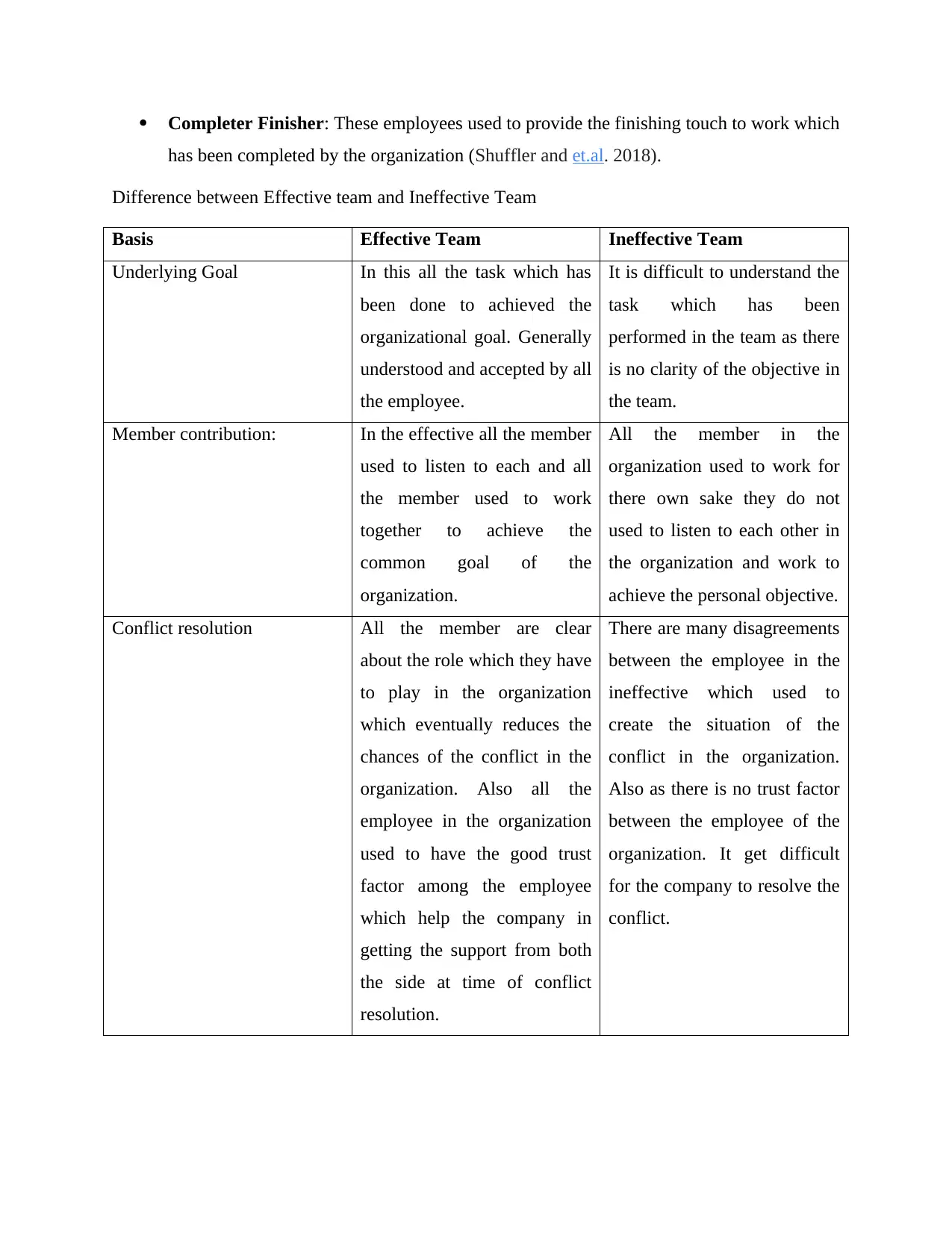
Completer Finisher: These employees used to provide the finishing touch to work which
has been completed by the organization (Shuffler and et.al. 2018).
Difference between Effective team and Ineffective Team
Basis Effective Team Ineffective Team
Underlying Goal In this all the task which has
been done to achieved the
organizational goal. Generally
understood and accepted by all
the employee.
It is difficult to understand the
task which has been
performed in the team as there
is no clarity of the objective in
the team.
Member contribution: In the effective all the member
used to listen to each and all
the member used to work
together to achieve the
common goal of the
organization.
All the member in the
organization used to work for
there own sake they do not
used to listen to each other in
the organization and work to
achieve the personal objective.
Conflict resolution All the member are clear
about the role which they have
to play in the organization
which eventually reduces the
chances of the conflict in the
organization. Also all the
employee in the organization
used to have the good trust
factor among the employee
which help the company in
getting the support from both
the side at time of conflict
resolution.
There are many disagreements
between the employee in the
ineffective which used to
create the situation of the
conflict in the organization.
Also as there is no trust factor
between the employee of the
organization. It get difficult
for the company to resolve the
conflict.
has been completed by the organization (Shuffler and et.al. 2018).
Difference between Effective team and Ineffective Team
Basis Effective Team Ineffective Team
Underlying Goal In this all the task which has
been done to achieved the
organizational goal. Generally
understood and accepted by all
the employee.
It is difficult to understand the
task which has been
performed in the team as there
is no clarity of the objective in
the team.
Member contribution: In the effective all the member
used to listen to each and all
the member used to work
together to achieve the
common goal of the
organization.
All the member in the
organization used to work for
there own sake they do not
used to listen to each other in
the organization and work to
achieve the personal objective.
Conflict resolution All the member are clear
about the role which they have
to play in the organization
which eventually reduces the
chances of the conflict in the
organization. Also all the
employee in the organization
used to have the good trust
factor among the employee
which help the company in
getting the support from both
the side at time of conflict
resolution.
There are many disagreements
between the employee in the
ineffective which used to
create the situation of the
conflict in the organization.
Also as there is no trust factor
between the employee of the
organization. It get difficult
for the company to resolve the
conflict.
Paraphrase This Document
Need a fresh take? Get an instant paraphrase of this document with our AI Paraphraser
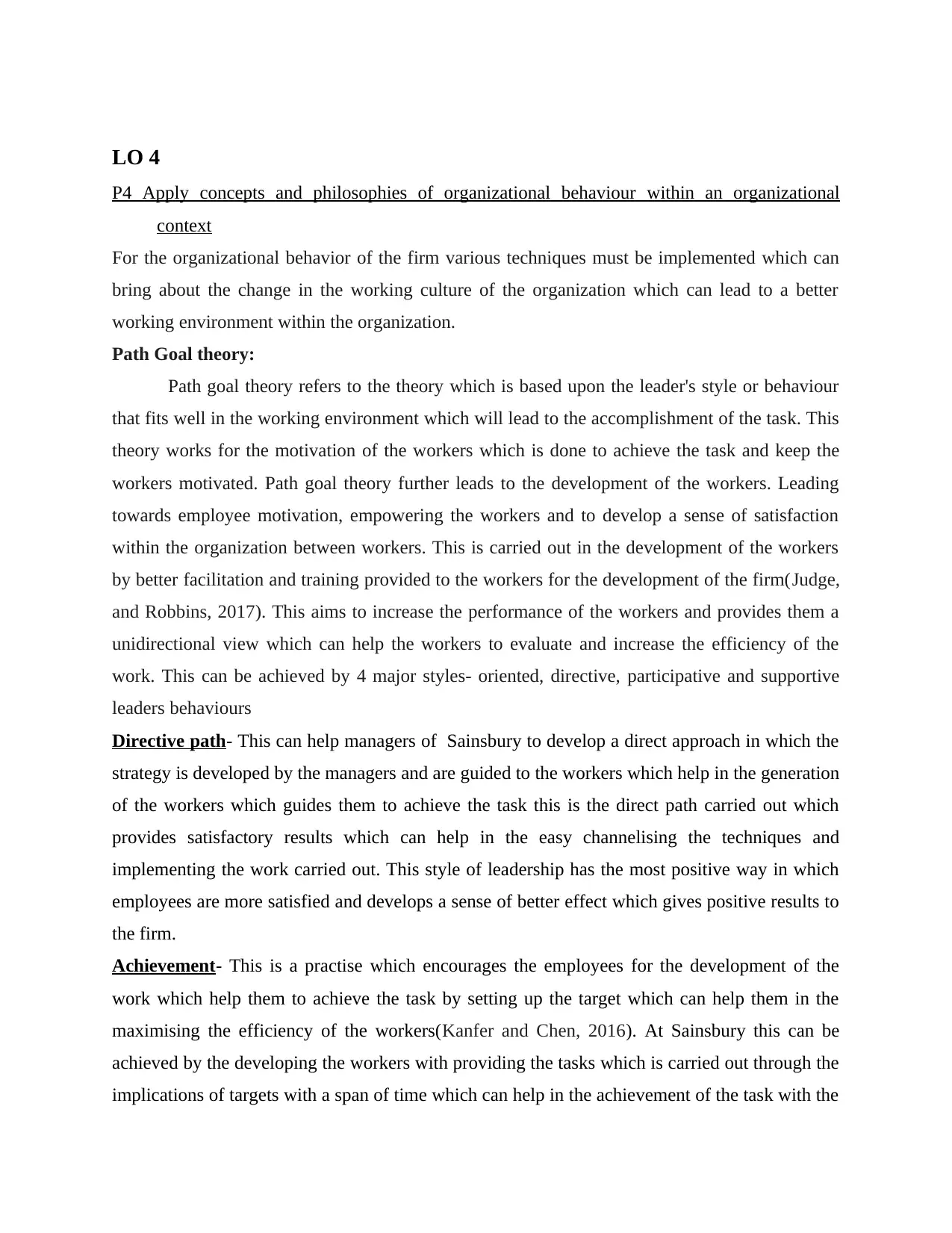
LO 4
P4 Apply concepts and philosophies of organizational behaviour within an organizational
context
For the organizational behavior of the firm various techniques must be implemented which can
bring about the change in the working culture of the organization which can lead to a better
working environment within the organization.
Path Goal theory:
Path goal theory refers to the theory which is based upon the leader's style or behaviour
that fits well in the working environment which will lead to the accomplishment of the task. This
theory works for the motivation of the workers which is done to achieve the task and keep the
workers motivated. Path goal theory further leads to the development of the workers. Leading
towards employee motivation, empowering the workers and to develop a sense of satisfaction
within the organization between workers. This is carried out in the development of the workers
by better facilitation and training provided to the workers for the development of the firm(Judge,
and Robbins, 2017). This aims to increase the performance of the workers and provides them a
unidirectional view which can help the workers to evaluate and increase the efficiency of the
work. This can be achieved by 4 major styles- oriented, directive, participative and supportive
leaders behaviours
Directive path- This can help managers of Sainsbury to develop a direct approach in which the
strategy is developed by the managers and are guided to the workers which help in the generation
of the workers which guides them to achieve the task this is the direct path carried out which
provides satisfactory results which can help in the easy channelising the techniques and
implementing the work carried out. This style of leadership has the most positive way in which
employees are more satisfied and develops a sense of better effect which gives positive results to
the firm.
Achievement- This is a practise which encourages the employees for the development of the
work which help them to achieve the task by setting up the target which can help them in the
maximising the efficiency of the workers(Kanfer and Chen, 2016). At Sainsbury this can be
achieved by the developing the workers with providing the tasks which is carried out through the
implications of targets with a span of time which can help in the achievement of the task with the
P4 Apply concepts and philosophies of organizational behaviour within an organizational
context
For the organizational behavior of the firm various techniques must be implemented which can
bring about the change in the working culture of the organization which can lead to a better
working environment within the organization.
Path Goal theory:
Path goal theory refers to the theory which is based upon the leader's style or behaviour
that fits well in the working environment which will lead to the accomplishment of the task. This
theory works for the motivation of the workers which is done to achieve the task and keep the
workers motivated. Path goal theory further leads to the development of the workers. Leading
towards employee motivation, empowering the workers and to develop a sense of satisfaction
within the organization between workers. This is carried out in the development of the workers
by better facilitation and training provided to the workers for the development of the firm(Judge,
and Robbins, 2017). This aims to increase the performance of the workers and provides them a
unidirectional view which can help the workers to evaluate and increase the efficiency of the
work. This can be achieved by 4 major styles- oriented, directive, participative and supportive
leaders behaviours
Directive path- This can help managers of Sainsbury to develop a direct approach in which the
strategy is developed by the managers and are guided to the workers which help in the generation
of the workers which guides them to achieve the task this is the direct path carried out which
provides satisfactory results which can help in the easy channelising the techniques and
implementing the work carried out. This style of leadership has the most positive way in which
employees are more satisfied and develops a sense of better effect which gives positive results to
the firm.
Achievement- This is a practise which encourages the employees for the development of the
work which help them to achieve the task by setting up the target which can help them in the
maximising the efficiency of the workers(Kanfer and Chen, 2016). At Sainsbury this can be
achieved by the developing the workers with providing the tasks which is carried out through the
implications of targets with a span of time which can help in the achievement of the task with the
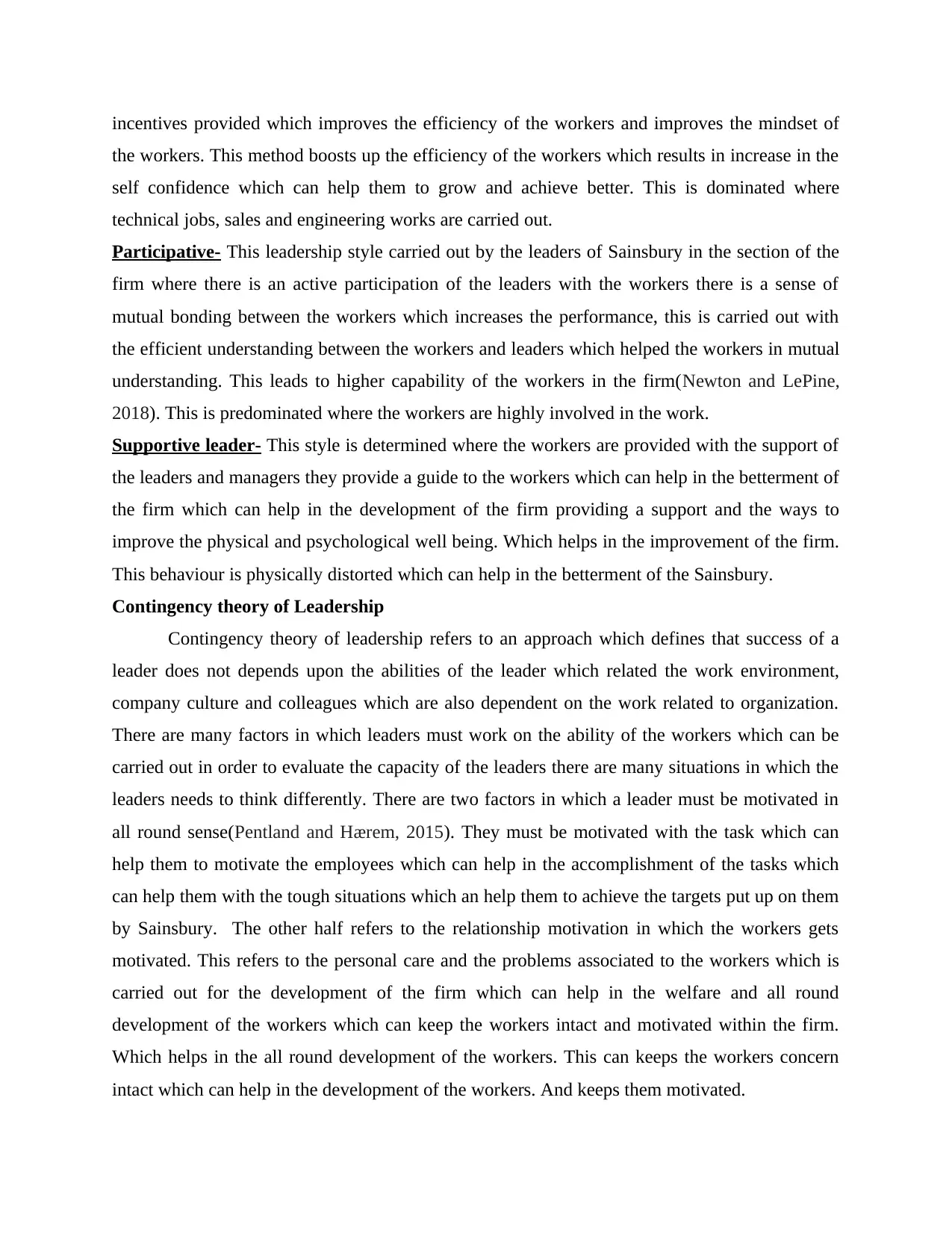
incentives provided which improves the efficiency of the workers and improves the mindset of
the workers. This method boosts up the efficiency of the workers which results in increase in the
self confidence which can help them to grow and achieve better. This is dominated where
technical jobs, sales and engineering works are carried out.
Participative- This leadership style carried out by the leaders of Sainsbury in the section of the
firm where there is an active participation of the leaders with the workers there is a sense of
mutual bonding between the workers which increases the performance, this is carried out with
the efficient understanding between the workers and leaders which helped the workers in mutual
understanding. This leads to higher capability of the workers in the firm(Newton and LePine,
2018). This is predominated where the workers are highly involved in the work.
Supportive leader- This style is determined where the workers are provided with the support of
the leaders and managers they provide a guide to the workers which can help in the betterment of
the firm which can help in the development of the firm providing a support and the ways to
improve the physical and psychological well being. Which helps in the improvement of the firm.
This behaviour is physically distorted which can help in the betterment of the Sainsbury.
Contingency theory of Leadership
Contingency theory of leadership refers to an approach which defines that success of a
leader does not depends upon the abilities of the leader which related the work environment,
company culture and colleagues which are also dependent on the work related to organization.
There are many factors in which leaders must work on the ability of the workers which can be
carried out in order to evaluate the capacity of the leaders there are many situations in which the
leaders needs to think differently. There are two factors in which a leader must be motivated in
all round sense(Pentland and Hærem, 2015). They must be motivated with the task which can
help them to motivate the employees which can help in the accomplishment of the tasks which
can help them with the tough situations which an help them to achieve the targets put up on them
by Sainsbury. The other half refers to the relationship motivation in which the workers gets
motivated. This refers to the personal care and the problems associated to the workers which is
carried out for the development of the firm which can help in the welfare and all round
development of the workers which can keep the workers intact and motivated within the firm.
Which helps in the all round development of the workers. This can keeps the workers concern
intact which can help in the development of the workers. And keeps them motivated.
the workers. This method boosts up the efficiency of the workers which results in increase in the
self confidence which can help them to grow and achieve better. This is dominated where
technical jobs, sales and engineering works are carried out.
Participative- This leadership style carried out by the leaders of Sainsbury in the section of the
firm where there is an active participation of the leaders with the workers there is a sense of
mutual bonding between the workers which increases the performance, this is carried out with
the efficient understanding between the workers and leaders which helped the workers in mutual
understanding. This leads to higher capability of the workers in the firm(Newton and LePine,
2018). This is predominated where the workers are highly involved in the work.
Supportive leader- This style is determined where the workers are provided with the support of
the leaders and managers they provide a guide to the workers which can help in the betterment of
the firm which can help in the development of the firm providing a support and the ways to
improve the physical and psychological well being. Which helps in the improvement of the firm.
This behaviour is physically distorted which can help in the betterment of the Sainsbury.
Contingency theory of Leadership
Contingency theory of leadership refers to an approach which defines that success of a
leader does not depends upon the abilities of the leader which related the work environment,
company culture and colleagues which are also dependent on the work related to organization.
There are many factors in which leaders must work on the ability of the workers which can be
carried out in order to evaluate the capacity of the leaders there are many situations in which the
leaders needs to think differently. There are two factors in which a leader must be motivated in
all round sense(Pentland and Hærem, 2015). They must be motivated with the task which can
help them to motivate the employees which can help in the accomplishment of the tasks which
can help them with the tough situations which an help them to achieve the targets put up on them
by Sainsbury. The other half refers to the relationship motivation in which the workers gets
motivated. This refers to the personal care and the problems associated to the workers which is
carried out for the development of the firm which can help in the welfare and all round
development of the workers which can keep the workers intact and motivated within the firm.
Which helps in the all round development of the workers. This can keeps the workers concern
intact which can help in the development of the workers. And keeps them motivated.
You're viewing a preview
Unlock full access by subscribing today!
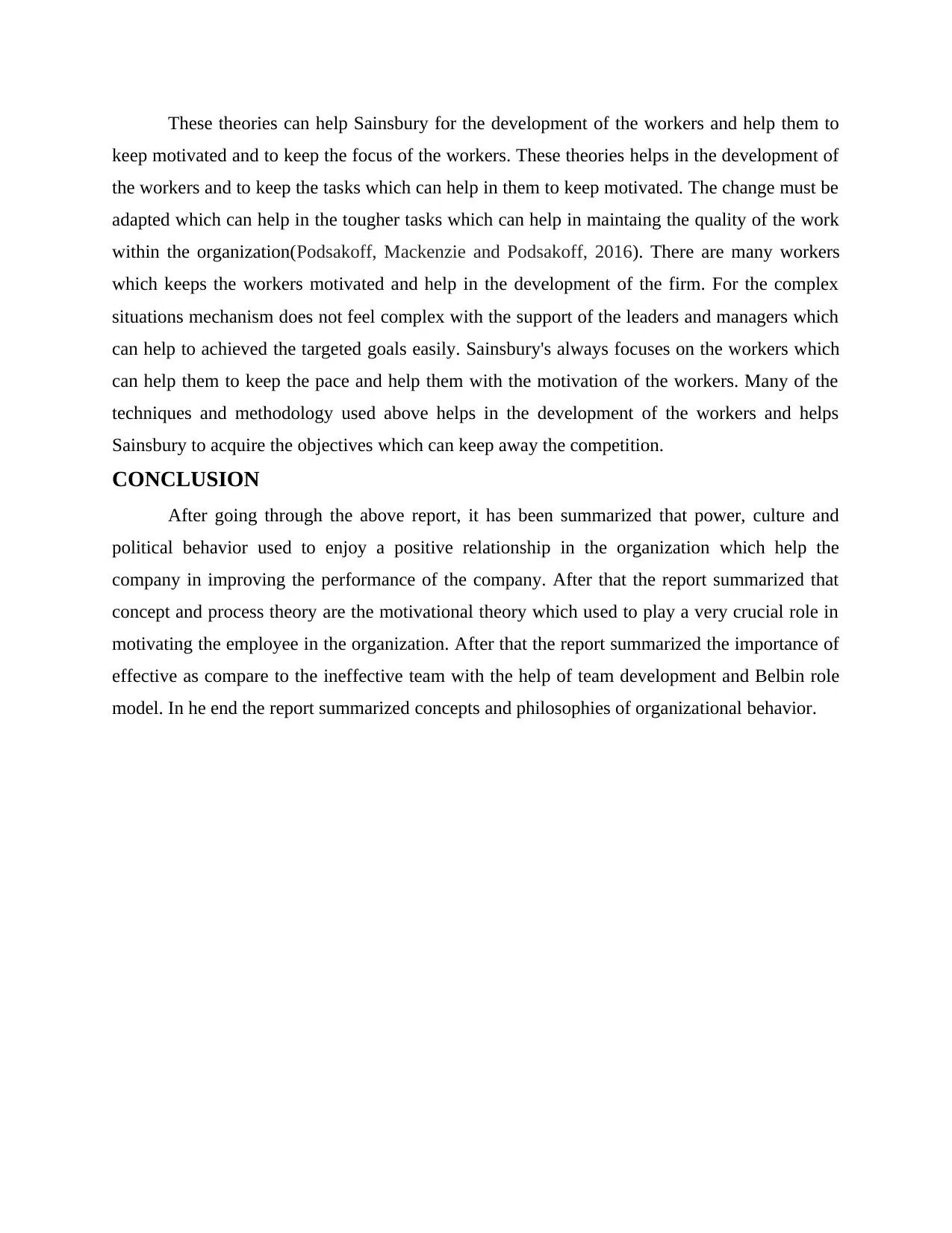
These theories can help Sainsbury for the development of the workers and help them to
keep motivated and to keep the focus of the workers. These theories helps in the development of
the workers and to keep the tasks which can help in them to keep motivated. The change must be
adapted which can help in the tougher tasks which can help in maintaing the quality of the work
within the organization(Podsakoff, Mackenzie and Podsakoff, 2016). There are many workers
which keeps the workers motivated and help in the development of the firm. For the complex
situations mechanism does not feel complex with the support of the leaders and managers which
can help to achieved the targeted goals easily. Sainsbury's always focuses on the workers which
can help them to keep the pace and help them with the motivation of the workers. Many of the
techniques and methodology used above helps in the development of the workers and helps
Sainsbury to acquire the objectives which can keep away the competition.
CONCLUSION
After going through the above report, it has been summarized that power, culture and
political behavior used to enjoy a positive relationship in the organization which help the
company in improving the performance of the company. After that the report summarized that
concept and process theory are the motivational theory which used to play a very crucial role in
motivating the employee in the organization. After that the report summarized the importance of
effective as compare to the ineffective team with the help of team development and Belbin role
model. In he end the report summarized concepts and philosophies of organizational behavior.
keep motivated and to keep the focus of the workers. These theories helps in the development of
the workers and to keep the tasks which can help in them to keep motivated. The change must be
adapted which can help in the tougher tasks which can help in maintaing the quality of the work
within the organization(Podsakoff, Mackenzie and Podsakoff, 2016). There are many workers
which keeps the workers motivated and help in the development of the firm. For the complex
situations mechanism does not feel complex with the support of the leaders and managers which
can help to achieved the targeted goals easily. Sainsbury's always focuses on the workers which
can help them to keep the pace and help them with the motivation of the workers. Many of the
techniques and methodology used above helps in the development of the workers and helps
Sainsbury to acquire the objectives which can keep away the competition.
CONCLUSION
After going through the above report, it has been summarized that power, culture and
political behavior used to enjoy a positive relationship in the organization which help the
company in improving the performance of the company. After that the report summarized that
concept and process theory are the motivational theory which used to play a very crucial role in
motivating the employee in the organization. After that the report summarized the importance of
effective as compare to the ineffective team with the help of team development and Belbin role
model. In he end the report summarized concepts and philosophies of organizational behavior.
Paraphrase This Document
Need a fresh take? Get an instant paraphrase of this document with our AI Paraphraser

REFERENCES
Books and Journals
Coxen, L., Van der Vaart, L. and Stander, M. W., 2016. Authentic leadership and
organisational citizenship behaviour in the public health care sector: The role of workplace
trust. SA Journal of Industrial Psychology. 42(1). pp.1-13.
Hackett, R.D. and et.al., 2018. Transformational Leadership and Organisational
Citizenship Behaviour: A Moderated Mediation Model of Leader‐Member‐Exchange and
Subordinates' Gender. Applied Psychology. 67(4). pp.617-644.
Judge, T.A. and Robbins, S.P., 2017. Essentials of organizational behavior.
Pearson Education (us).
Kanfer, R. and Chen, G., 2016. Motivation in organizational behavior: History,
advances and prospects. Organizational Behavior and Human Decision Processes. 136.
pp.6-19.
Naz, S. and et.al., 2019. Linking emotional intelligence to knowledge sharing behaviour:
mediating role of job satisfaction and organisational commitment. Middle East Journal of
Management. 6(3). pp.318-340.
Newton, D.W. and LePine, J.A., 2018. Organizational Citizenship Behavior and Job
Engagement:“You Gotta Keep’em Separated!”. The Oxford Handbook of Organizational
Citizenship Behavior, p.43.
Pentland, B.T. and Hærem, T., 2015. Organizational routines as patterns of action:
Implications for organizational behavior. Annu. Rev. Organ. Psychol. Organ. Behav. 2(1).
pp.465-487.
Peter, B. and Chima, O.B., 2018. Organisational Cynicism and Employees’ Intention to
Quit. International Journal of Management Science. 5(1). pp.6-9.
Podsakoff, P.M., Mackenzie, S.B. and Podsakoff, N.P., 2016. Organizational citizenship
behavior: introduction and overview of the handbook. In The Oxford Handbook of
Organizational Citizenship Behavior. New York, NY: Oxford University Press.
Rao, H.M., 2018. Determinants of organisational citizenship behaviour and
organisational performance in automobile sales professionals (Doctoral dissertation, Sheffield
Hallam University).
Smith, D., Machin, M.A. and Beccaria, G., 2017. The Organisational Socio-Ecological
(In) Civility Model: framing multilevel (in) civility effects on employees within organisational
climate and culture.
Hu, J. and Liden, R. C., 2015. Making a difference in the teamwork: Linking team prosocial
motivation to team processes and effectiveness. Academy of Management Journal, 58(4),
pp.1102-1127.
Kozlowski, S. W. and et.al., 2015. Teams, teamwork, and team effectiveness: Implications for
human systems integration.
Shuffler, M. L. and et.al. 2018. Developing, sustaining, and maximizing team effectiveness: An
integrative, dynamic perspective of team development interventions. Academy of
Management Annals.12(2). pp.688-724.
Online
Books and Journals
Coxen, L., Van der Vaart, L. and Stander, M. W., 2016. Authentic leadership and
organisational citizenship behaviour in the public health care sector: The role of workplace
trust. SA Journal of Industrial Psychology. 42(1). pp.1-13.
Hackett, R.D. and et.al., 2018. Transformational Leadership and Organisational
Citizenship Behaviour: A Moderated Mediation Model of Leader‐Member‐Exchange and
Subordinates' Gender. Applied Psychology. 67(4). pp.617-644.
Judge, T.A. and Robbins, S.P., 2017. Essentials of organizational behavior.
Pearson Education (us).
Kanfer, R. and Chen, G., 2016. Motivation in organizational behavior: History,
advances and prospects. Organizational Behavior and Human Decision Processes. 136.
pp.6-19.
Naz, S. and et.al., 2019. Linking emotional intelligence to knowledge sharing behaviour:
mediating role of job satisfaction and organisational commitment. Middle East Journal of
Management. 6(3). pp.318-340.
Newton, D.W. and LePine, J.A., 2018. Organizational Citizenship Behavior and Job
Engagement:“You Gotta Keep’em Separated!”. The Oxford Handbook of Organizational
Citizenship Behavior, p.43.
Pentland, B.T. and Hærem, T., 2015. Organizational routines as patterns of action:
Implications for organizational behavior. Annu. Rev. Organ. Psychol. Organ. Behav. 2(1).
pp.465-487.
Peter, B. and Chima, O.B., 2018. Organisational Cynicism and Employees’ Intention to
Quit. International Journal of Management Science. 5(1). pp.6-9.
Podsakoff, P.M., Mackenzie, S.B. and Podsakoff, N.P., 2016. Organizational citizenship
behavior: introduction and overview of the handbook. In The Oxford Handbook of
Organizational Citizenship Behavior. New York, NY: Oxford University Press.
Rao, H.M., 2018. Determinants of organisational citizenship behaviour and
organisational performance in automobile sales professionals (Doctoral dissertation, Sheffield
Hallam University).
Smith, D., Machin, M.A. and Beccaria, G., 2017. The Organisational Socio-Ecological
(In) Civility Model: framing multilevel (in) civility effects on employees within organisational
climate and culture.
Hu, J. and Liden, R. C., 2015. Making a difference in the teamwork: Linking team prosocial
motivation to team processes and effectiveness. Academy of Management Journal, 58(4),
pp.1102-1127.
Kozlowski, S. W. and et.al., 2015. Teams, teamwork, and team effectiveness: Implications for
human systems integration.
Shuffler, M. L. and et.al. 2018. Developing, sustaining, and maximizing team effectiveness: An
integrative, dynamic perspective of team development interventions. Academy of
Management Annals.12(2). pp.688-724.
Online
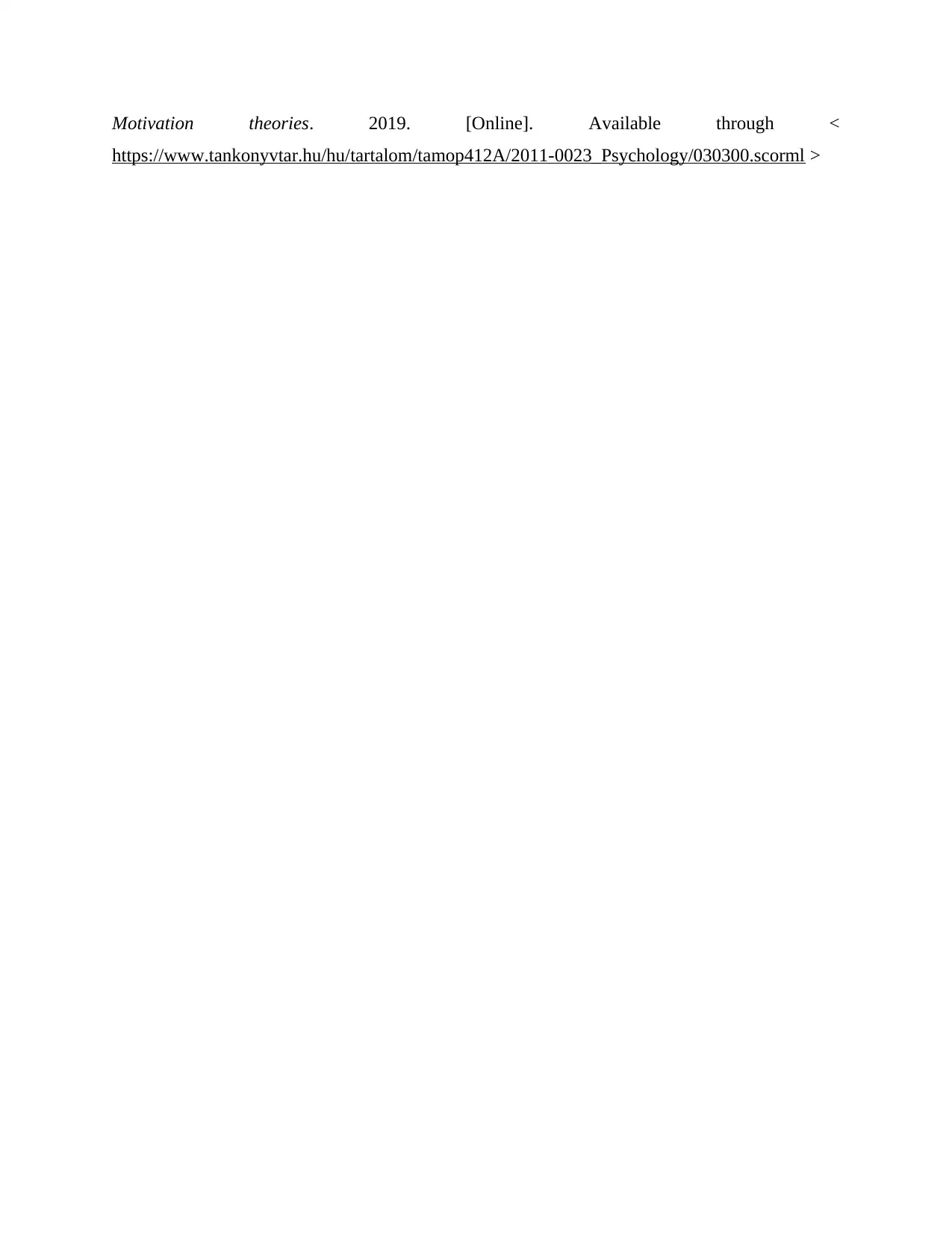
Motivation theories. 2019. [Online]. Available through <
https://www.tankonyvtar.hu/hu/tartalom/tamop412A/2011-0023_Psychology/030300.scorml >
https://www.tankonyvtar.hu/hu/tartalom/tamop412A/2011-0023_Psychology/030300.scorml >
You're viewing a preview
Unlock full access by subscribing today!
1 out of 15
Related Documents
Your All-in-One AI-Powered Toolkit for Academic Success.
+13062052269
info@desklib.com
Available 24*7 on WhatsApp / Email
![[object Object]](/_next/static/media/star-bottom.7253800d.svg)
Unlock your academic potential
© 2024 | Zucol Services PVT LTD | All rights reserved.





